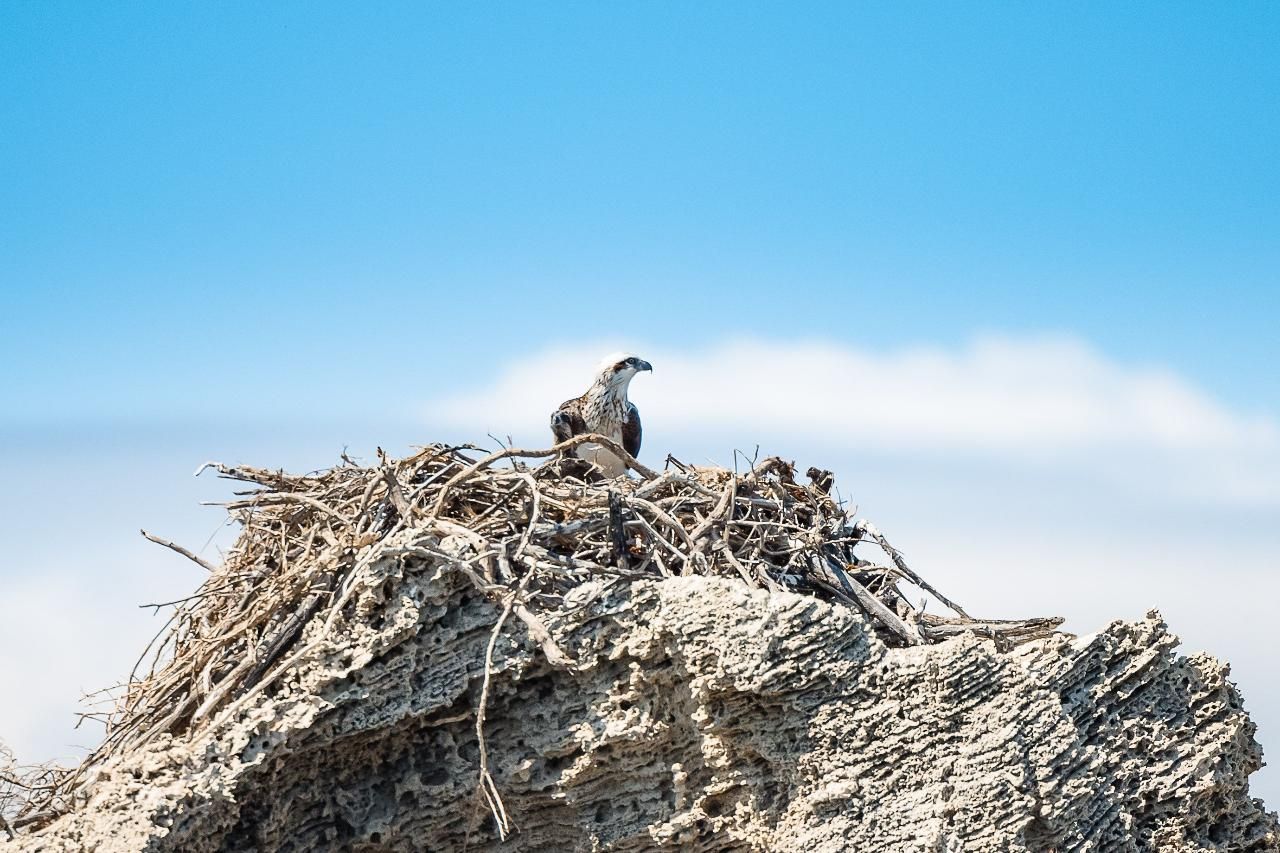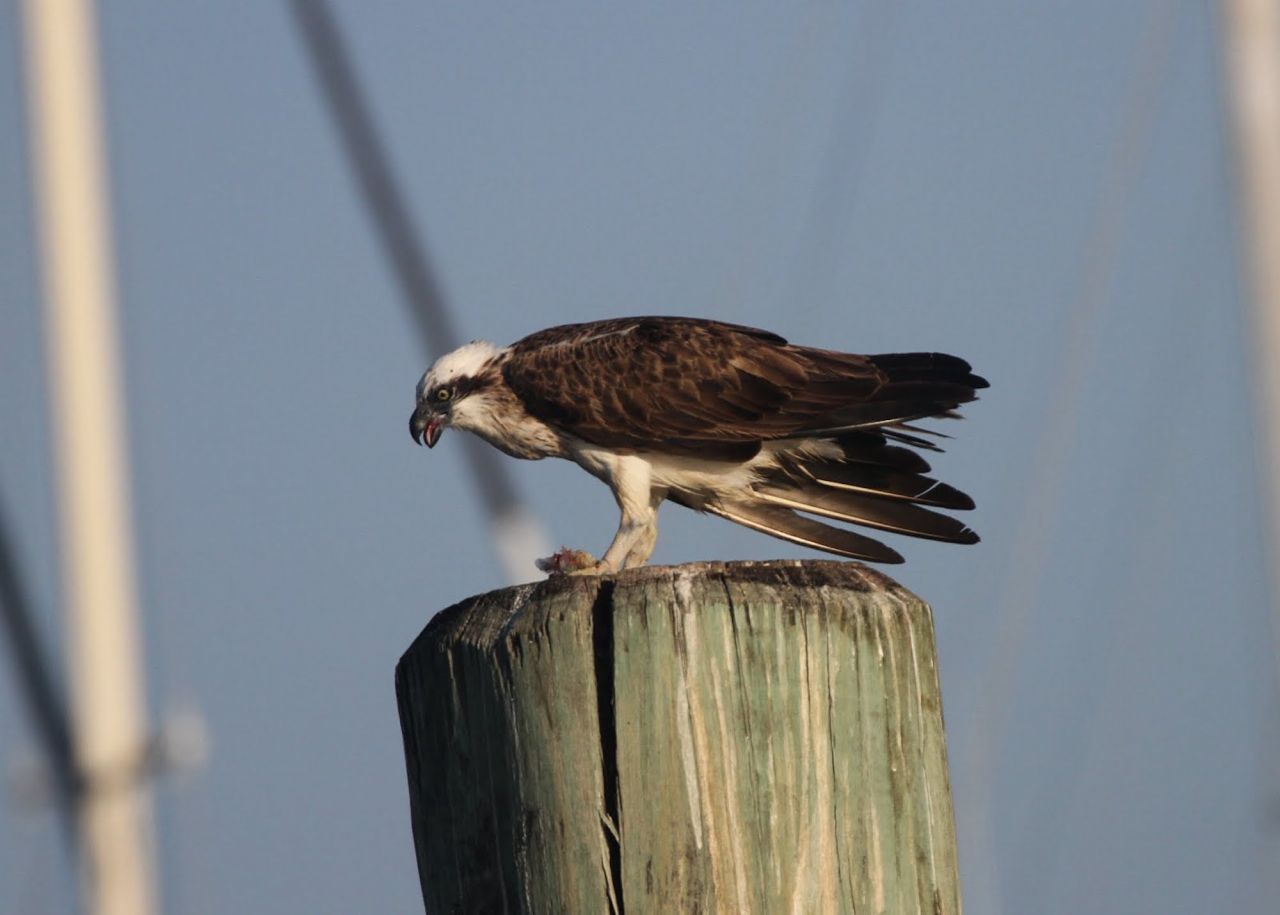Graceful, powerful, and unmistakable in flight, the Eastern Osprey (Pandion cristatus) is a distinctive raptor found along Australia's coastal fringes. With a sharp eye for fish and a unique aerial hunting style, this coastal bird of prey is an integral part of marine ecosystems across northern and eastern Australia. Once considered a subspecies of the global osprey (Pandion haliaetus), the Eastern Osprey is now recognised as a separate species endemic to the Indo-Pacific region.
Cultural and Ecological Importance
The Eastern Osprey holds significance in coastal Aboriginal culture, often associated with the sea and marine life. As a top predator in its food chain, it plays an important ecological role in regulating fish populations and indicating the health of aquatic ecosystems.
Size and appearance
Eastern Ospreys are medium-sized raptors, with a wingspan of up to 1.7 metres (5.5 ft) and a body length of around 55-65 cm (21-26 in). Females are typically larger than males, weighing up to 2 kg (4.4 lb), while males weigh slightly less.
Their plumage is distinctive: white underparts, a dark brown back, and a striking dark eye-stripe extending from the beak across the eyes to the sides of the neck. The crown and forehead are white, often slightly crested. In flight, their long, narrow wings show a strong kink at the wrist, giving them an M-shaped silhouette. Their strong, curved talons and spiny footpads are specialised for gripping slippery prey like fish.
Diet
Fish make up almost 100% of the Eastern Osprey's diet. They are skilled hunters, soaring or hovering over coastal waters, estuaries, and inland lakes before diving feet-first to snatch fish from just below the water's surface. They typically carry their catch with the head forward for aerodynamic flight back to a perch or nest.
Occasionally, they will eat other aquatic animals, but their hunting is highly specialised, and they rarely scavenge or consume terrestrial prey.

An Eastern Osprey on a large nest in Western Australia. Image: Perth Wildlife Encounters.
Breeding
Eastern Ospreys are monogamous and tend to use the same nest sites year after year. Nests are large, bulky structures made from sticks, lined with softer materials, and usually located in high, open locations, such as dead trees, cliff ledges, or artificial platforms.
Breeding typically occurs between May and September in the south and April to July in northern regions. The female lays 2-3 eggs, which are incubated for about 35-43 days. After hatching, chicks remain in the nest for up to 60 days before fledging. Both parents are involved in raising the young.
These long-lived birds (some reaching 20-25 years) take several years to mature and breed.

An Eastern Osprey with prey in its talons. Image: Pacific Whale Foundation Eco-Adventures Australia.
Conservation
The Eastern Osprey is not globally threatened and is currently listed as Least Concern by the IUCN. However, in Australia, regional populations face varying degrees of pressure. In New South Wales, the species is listed as Vulnerable, and in South Australia, it is listed as Rare due to declining numbers and habitat loss along developed coastlines.
Major threats include:
- Loss of nesting habitat due to coastal development and the removal of mature trees
- Disturbance near nesting sites from human activity
- Pollution, which impacts the health of fish populations and aquatic ecosystems
- Entanglement in fishing lines and accumulation of marine debris in nests
One of the most innovative conservation efforts can be seen in Port Lincoln, South Australia, where a community-led initiative monitors a long-established Eastern Osprey nest on a barge at the entrance to Lincoln Cove Marina. Since 2015, the nest has been maintained by local volunteers, relocated to a more stable barge, and fitted with a solar-powered security camera, enabling a 24/7 livestream of the nesting activity. This not only contributes to osprey conservation through monitoring and education, but also offers a rare window into their nesting behaviour.
Watch the live stream
Interestingly, the Port Lincoln Ospreys do not migrate and are relatively free of predation, but have still experienced challenges such as siblicide, where stronger chicks outcompete their siblings despite ample food supply. The nest itself is an impressive 1.25 x 1.5 metres - a testament to the species' dedication to reuse and repair over many years.
Conservation programs like these are crucial for the long-term survival of regional osprey populations and offer inspiring examples of how community engagement and technology can work hand in hand to protect wildlife.

Eastern Osprey in flight. Image: Australian Coastal Safaris.
Where to see eastern osprey in the wild
Eastern Osprey are most commonly found along the coasts of Queensland, New South Wales, Northern Territory, Western Australia, and parts of South Australia and Victoria. They frequent bays, estuaries, mangroves, reefs, and offshore islands.
Some great places to spot them include:
Eyre Peninsula, South Australia
Suggested Eyre Peninsula tours:
- Southern Eyre Peninsula Birdwatching (3 days) - Australian Coastal Safaris
- Eyre Peninsula Wildlife & Ocean Encounters (3 days) - Australian Coastal Safaris
- Port Lincoln Wildlife Encounters (2 days) - Australian Coastal Safaris
Kangaroo Island, South Australia
Suggested Kangaroo Island tours:
- Kangaroo Island Birding Tour (3 days) - Exceptional Kangaroo Island
- Kangaroo Island Wildlife Photography Tour (3 days) - Exceptional Kangaroo Island
- Conservation Connection (3 days) - Exceptional Kangaroo Island
Hervey Bay, Queensland
Suggested Hervey Bay tours:
- Hervey Bay Nature Cruise (2 hours) - Pacific Whale Foundation Eco-Adventures Australia
- Ultimate Hervey Bay Whale Watching (3 hours) - Pacific Whale Foundation Eco-Adventures Australia
Perth, Western Australia
Suggested Perth tours:
- 3 Islands Wildlife Snorkel (4 hours) - Perth Wildlife Encounters
- Dolphin, Sea Lion & Penguin Island Cruise (2 hours) - Perth Wildlife Encounters
Margaret River, Western Australia
Suggested Margaret River tours:
- Augusta Whale Watching (2.5 hours) - Naturaliste Charters
- Dunsborough Whale Watching (2.5 hours) - Naturaliste Charters
Join a local birdwatching or wildlife tour for your best chance of spotting these spectacular raptors up close.
FAQs
Is the Eastern Osprey the same as the common Osprey found overseas?
They were once considered a subspecies but are now classified as a separate species (Pandion cristatus), endemic to the Indo-Pacific.
Do Eastern Ospreys migrate?
Eastern Ospreys are generally sedentary, with juveniles dispersing locally. Some individuals may move north during colder months.
How do they differ from Sea-Eagles?
Eastern Ospreys are smaller, have shorter wings, and hunt only fish. They can be distinguished from White-bellied Sea-Eagles by their slimmer build, distinctive M-shaped wing profile, and hovering flight.

